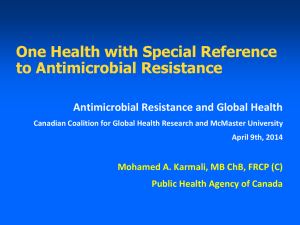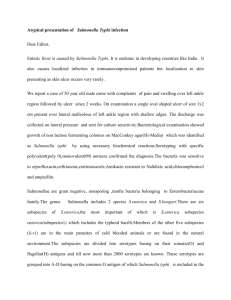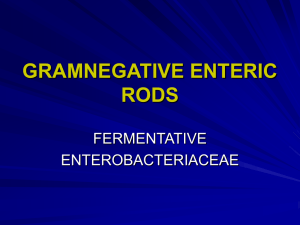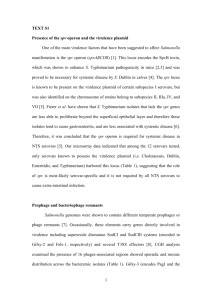Asian Journal of Medical Sciences 4(1): 37-41, 2012 ISSN: 2040-8773
advertisement
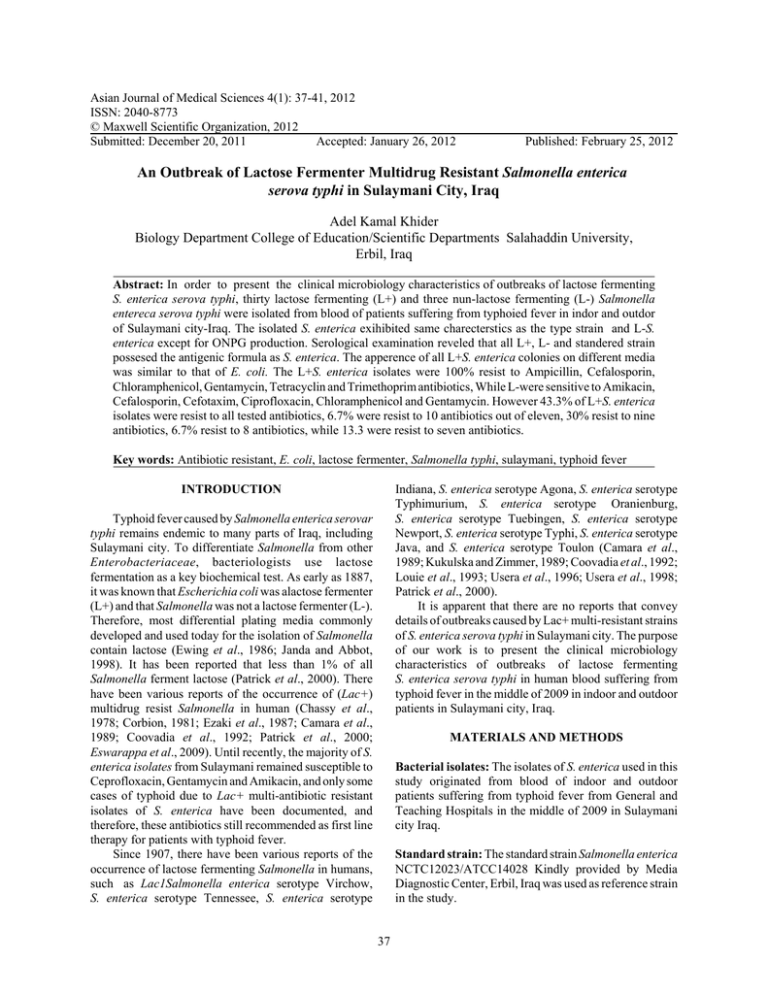
Asian Journal of Medical Sciences 4(1): 37-41, 2012 ISSN: 2040-8773 © Maxwell Scientific Organization, 2012 Submitted: December 20, 2011 Accepted: January 26, 2012 Published: February 25, 2012 An Outbreak of Lactose Fermenter Multidrug Resistant Salmonella enterica serova typhi in Sulaymani City, Iraq Adel Kamal Khider Biology Department College of Education/Scientific Departments Salahaddin University, Erbil, Iraq Abstract: In order to present the clinical microbiology characteristics of outbreaks of lactose fermenting S. enterica serova typhi, thirty lactose fermenting (L+) and three nun-lactose fermenting (L-) Salmonella entereca serova typhi were isolated from blood of patients suffering from typhoied fever in indor and outdor of Sulaymani city-Iraq. The isolated S. enterica exihibited same charecterstics as the type strain and L-S. enterica except for ONPG production. Serological examination reveled that all L+, L- and standered strain possesed the antigenic formula as S. enterica. The apperence of all L+S. enterica colonies on different media was similar to that of E. coli. The L+S. enterica isolates were 100% resist to Ampicillin, Cefalosporin, Chloramphenicol, Gentamycin, Tetracyclin and Trimethoprim antibiotics, While L-were sensitive to Amikacin, Cefalosporin, Cefotaxim, Ciprofloxacin, Chloramphenicol and Gentamycin. However 43.3% of L+S. enterica isolates were resist to all tested antibiotics, 6.7% were resist to 10 antibiotics out of eleven, 30% resist to nine antibiotics, 6.7% resist to 8 antibiotics, while 13.3 were resist to seven antibiotics. Key words: Antibiotic resistant, E. coli, lactose fermenter, Salmonella typhi, sulaymani, typhoid fever Indiana, S. enterica serotype Agona, S. enterica serotype Typhimurium, S. enterica serotype Oranienburg, S. enterica serotype Tuebingen, S. enterica serotype Newport, S. enterica serotype Typhi, S. enterica serotype Java, and S. enterica serotype Toulon (Camara et al., 1989; Kukulska and Zimmer, 1989; Coovadia et al., 1992; Louie et al., 1993; Usera et al., 1996; Usera et al., 1998; Patrick et al., 2000). It is apparent that there are no reports that convey details of outbreaks caused by Lac+ multi-resistant strains of S. enterica serova typhi in Sulaymani city. The purpose of our work is to present the clinical microbiology characteristics of outbreaks of lactose fermenting S. enterica serova typhi in human blood suffering from typhoid fever in the middle of 2009 in indoor and outdoor patients in Sulaymani city, Iraq. INTRODUCTION Typhoid fever caused by Salmonella enterica serovar typhi remains endemic to many parts of Iraq, including Sulaymani city. To differentiate Salmonella from other Enterobacteriaceae, bacteriologists use lactose fermentation as a key biochemical test. As early as 1887, it was known that Escherichia coli was alactose fermenter (L+) and that Salmonella was not a lactose fermenter (L-). Therefore, most differential plating media commonly developed and used today for the isolation of Salmonella contain lactose (Ewing et al., 1986; Janda and Abbot, 1998). It has been reported that less than 1% of all Salmonella ferment lactose (Patrick et al., 2000). There have been various reports of the occurrence of (Lac+) multidrug resist Salmonella in human (Chassy et al., 1978; Corbion, 1981; Ezaki et al., 1987; Camara et al., 1989; Coovadia et al., 1992; Patrick et al., 2000; Eswarappa et al., 2009). Until recently, the majority of S. enterica isolates from Sulaymani remained susceptible to Ceprofloxacin, Gentamycin and Amikacin, and only some cases of typhoid due to Lac+ multi-antibiotic resistant isolates of S. enterica have been documented, and therefore, these antibiotics still recommended as first line therapy for patients with typhoid fever. Since 1907, there have been various reports of the occurrence of lactose fermenting Salmonella in humans, such as Lac1Salmonella enterica serotype Virchow, S. enterica serotype Tennessee, S. enterica serotype MATERIALS AND METHODS Bacterial isolates: The isolates of S. enterica used in this study originated from blood of indoor and outdoor patients suffering from typhoid fever from General and Teaching Hospitals in the middle of 2009 in Sulaymani city Iraq. Standard strain: The standard strain Salmonella enterica NCTC12023/ATCC14028 Kindly provided by Media Diagnostic Center, Erbil, Iraq was used as reference strain in the study. 37 Asian. J. Med. Sci., 4(1): 37-41, 2012 Table 1: Some biochemical tests of S. entereca Sources of Kliglar Bacteria isolates Oxidase (slope) ! Red alkaline 30 L+ S. typhi Blood ! Red alkaline 3 L- S. typhi Blood Standard strain MCI ! Red alkaline +: Positive; -: Negative Kligler (bottom) Acid yallow Acid yallow Acid yallow Minitol H2S production fermentation Little H2S + + + Bacteriology: Acid production from carbohydrates was tested in purple broth base, supplemented with 0.1 volume of a sterile 10% solution of each carbohydrate. The colonies were then screened for H2Sproduction and concurrently for lysine decarboxylase activity. Screening for H2S production (black precipitate in the medium) was done with sulfide-indole-motility agar medium, and Kligler agar (Andrews and Hammack, 2000). In addition a commercial identification system API 20E system was used. Acid formation Xylose + + + Indolformati + + + Lactose fermentation + ! ! sugar iron agar yellow (Butt and slant) without gas formation. Indol production was observed on suitable media, these L+ isolates produced a small quantity of H2S when grow on KI agar Table 1. Serological examination revealed that all lactose fermenters, three nun fermenting-lactose and standard strain possessed the antigenic formula of S. enterica. Thus, all lactose-fermenting isolates were identified as strains of S. enterica serova typhi, and the febrile illness was diagnosed as typhoid fever caused by lactosefermenting S. enterica serova typhi. The overall appearance of the Lac+ S. typhi colonies on different media was similar to that of E. coli, i.e., they appeared as rough, flat, lactose-fermenting bacterial colonies. All isolates recovered from plating on MacConky agar yielded rough, red colonies, and on Levine eosin-methylene blue agar, the colonies looked like small, rough, 2-4 mm green sequins with metallic sheen. The L+ isolates were 100% resist to Amp, Cef, Chl, Gm, Tet and Tri antibiotics, whereas the L- dissociate was sensitive to, Ak, Cef, Cfm, Cip, Chl and Gm antibiotics Table 2. Serological examination test: Direct testing of colonies by slide agglutination tests were performed by using Oantisera, H and Vi antisera according to (Andrews and Hammack, 2000). Standard bacterial strain Salmonella enterica NCTC12023/ATCC14028 was used as quality controls in these assays. Susceptibility to antimicrobial agents: The susceptibility of the thirty lactose fermenting S. enterica isolates and three lactose-non fermenting colonial dissociate against eleven antimicrobial agents (Amikacin Ak, Ampicillin Amp, Cefalosporin Cef, Cefotaxim Cfm, Ciprofloxacin Cip, Chloramphenicol Chl, Gentamycin Gm, Rifampicin Rif, Striptomycin Str, Tetracyclin Tet and Trimethoprim Tri) was determined by means of disk diffusion method (Atlas et al., 1995). DISCUSSION Thirty isolates of lactose fermenting S. enterica serova typhi were isolated from blood of in patients and outpatients of teaching and general Hospitals, in Sulaymani city, Iraq. Lactose-fermenting S. enterica isolates obtained as the etiological agent of patients suffering from typhoid fever. All these isolates when identified were exhibited the same characteristics as the non-lactose fermented S. enterica, and standard strain except for $-galactosidase (ONPG) enzyme production, these colonies were similar to that of E. coli. The $galactosidase enzyme produced by strains of Lac+Salmonella differs from E. coli $-galactosidase, offering further evidence that the operon did not originate from E. coli but could have originated from an enterobacterial ancestor common to E. coli (Cornelis, 1981; MacDonald and Riley, 1983; McClelland et al., 2001). Bacteria belonging to the genus Salmonella are closely related to those belonging to the genus Escherichia and they have diverged from a common ancestor about 100 million years ago (Doolittle et al., 1996). Despite their close relationship, E. coli has more than 800 genes that are absent in the S. enterica genome and more than 1, 100 S. enterica genes lack their homologues in E. coli (McClelland et al., 2001). The RESULTS The thirty lactose-fermenting isolates (L+) and three nun-lactose fermenting isolates (L-) exhibited the same characteristics as the type strain of S. enterica except for ONPG production, These L+ isolates were produced acid from lactose in purple broth base and were positive in Onitrophenyl-beta-D- galactosidase (ONPG) test in the API 20E system. The L-isolates show an acid butt and alkaline slant on kligler (Kl) agar with small quantity of H2S visible in the Butt, these isolates produced no acid in purple broth base supplemented with lactose and gave a negative reaction in the ONPG test. Moreover the profile number obtained for API 20E test from the L+ isolates (7404543) were identified correctly. Standard strain was negative lactose fermented with the profile number of API 20 E test (6404540). Acid from xylose for all L+, and L- isolate was positive Table 1. The lactose fermenting isolates consisted of motile, oxidase-negative, gram-negative rods. They produce colonies on MacConkey agar and turned triple 38 Asian. J. Med. Sci., 4(1): 37-41, 2012 Table 2: Antibiogram of S. entereca isolated from blood of patient seafaring from typhoid fiver Antibiotics Antibiogram groups ------------------------------------------------------------------------------------------------of L+ S. typhi Isolates number Ak Chl Amp Cef Cfm Rif Gm Cip str Tet Tri 1 5,8,9,11,12,15,18,19,21,24,26,27,28 R R R R R R R R R R R 2 3,10 S R R R R R R R R R R 3 20,25 R R R R S S R R R R R 4 7,13,16,17,22,29,30 S R R R S R R R R R R 5 14,23 S R R R S S R R R R R 6 2 S R R R R S R S S R R 7 1,4,6 S R R R S S R S R R R L- S. typhi isolates S S R S S R S S R R R R: Resist to antibiotics; S: Sensitive to antibiotics Table 3: Resistant of L+ S. entereca isolates to use antibiotics % of L+ S. typi isolates Antibiotics 43.311 11 6.710 10 30.09 9 6.78 8 13.37 7 region containing Lac+ and Lac operon is one such locus and is present in E. coli, but absent in S. enterica. Thus E. coli is a lactose fermenter, whereas S. enterica is lactose non-fermenter. Nonetheless, diseases caused by lactose fermentation in extra-chromosomal genetic elements like plasmids (Patrick et al., 2000; Eswarappa et al., 2009), these elements can be horizontally transferred and acquired by bacteria (Hensel, 2004). The Lac operon consists of three genes, lacZ, lac Y and lac A which encode $-galactosidase (Wilson et al., 2007). In this study and during the diagnosing it have been through that these isolates are resembling the E. coli. Kohabata et al. (1983) thought that these L+ S. enterica isolates were to be identical to a strain 643 Lac+ harboring the (Lac+) plasmid from ST-2 strain, strain 643 Lac+ was derived from typical S. enterica 643 treated with the episome of strain ST-2 during the course of a genetic experiment. Thus, there have been some Salmonellosis reports of typhoid fever due to a naturally occurring Lac+ S. enterica from different countries (LeMlnor et al., 1974; Ananel et al., 1980; Yanazaki and Kubota, 1982; Coovadia et al., 1992; Patrick et al., 2000; Wilson et al., 2007). The environment contain not only salmonellae but also other enteric bacteria, such as Klebsiella pneumoniae (MacDonald and Riley, 1983; Lucain and Piffaretti, 1983; Walia et al., 1987), Lactobacillus (Chassy et al., 1978), Proteus (Walia et al., 1987), and Serratia (Walia et al., 1987), which may carry the lactose operon on a plasmid or, in the case of some Klebsiella strains, on the chromosome (MacDonald and Riley, 1983). One theory for the origin of Lac in these plasmids involves the unlikely transfer of the operon from the chromosome of another enteric bacterium (E. coli) via a transposon (Cornelis, 1981) Some strains of Klebsiella carry the lac gene on the chromosome, there is evidence for may contain determinants of antimicrobial resistance, and there have been reports of outbreaks of Lac+ and antimicrobial agent-resistant Salmonella in the literature (Timoney et al., 1980; Threlfall et al., 1983; Ezaki et al., 1987). However 43.3% of our lactose fermenting S. enterica isolates were resist in vitro to all antimicrobials used, 6.7% were resist to 10 out of eleven antibiotics, 30% resist to nine antibiotics, 6.7% resist to 8 antibiotics, while 13.3 were resist to seven antibiotics Table 3. All L+S. enterica isolates were 100% resist to Chl, Cef, Amp, Gm, Tet, and Tri, whereas the L-S. enterica isolates were sensitive to Ak, Cef, Chl, Cfm, Cip and Gm, and in some cases resistant to Chl. Multi-drug resist S. enterica which is reported in this study seems to confirm other reports of other workers (Nadgir et al., 1998; Shrikala et al., 1999; Sanghavi et al., 1999; shrigala, 2004). Cefalosporin, ciprofloxacin and Gentamycin has long been the known as the drug of choice for the treatment of typhoid fever in Sulaymani hospitals. S. enterica is widely distributed in our environment and responsible for a wide range of clinical conditions some of them are fatal if untreated properly due to mistake in diagnosis specially typhoid fever and meningitis (Allen et al., 2003). The early administration of antibiotic treatment has proven to be highly effective in eliminating infections, but indiscriminate use of antibiotics due to incorrect identification has led to the emergence of multidrug-resistant strains of S. enterica serovar Typhi. After the cases due to a lactose-fermenting isolates occurred in August-October 2009, there has been no additional clinical cases of typhoid fever in indoor or outdoor patient were recorded in Sulaymani city, and the Ceftraiaxone was the main antibiotic for controlling typhoid fever in Sulaymani city. ACKNOWLEDGMENT We thank Sabiha S. Salih in Technical Agriculture Institute, Sulaymani, Iraq for her help during isolation of isolates, and MDC center in Erbil, for their cooperation and providing the S. enterica strain. REFERENCES Allen, H.R., G.L. Alison, D.C. Harry and S. Maloy, 2003. Genetic rearrangements atrrn operons in salmonella. Geneticsvol. 165: 95-959. 39 Asian. J. Med. Sci., 4(1): 37-41, 2012 Kukulska, D. and A. Zimmer, 1989. Selected properties of lactose-fermenting and non-fermenting Salmonella agona strains isolated fromspecimens from hospitalized infants. Med. Dosw. Mikrobiol., 41:115-120. Kohabata, S., M.T. akahashi and E. Yabuuchi, 1983. Lactose fermenting multipledruge-resistant Salmonella typhi strains isolated from a patient with post operative typhoid fever. J. Clin. Microbiol., 18(4): 920-925. LeMlnor, L., C. Coynault and G. Pessoa, 1974. Determinisme plasmid ique du caractere atypique (lactose positif) de souches de S. typhimurium et S.oranienburg isolees au Bresillorsd'epiddmies de 1971 a 1973. Ann. Microbiol. (Inst. Pasteur), 125A: 261-285. Louie, K.K., A.M. Paccagnella, W.D. sOsei, H. Lior, B.J. Francis and M.T. Osterholm, 1993. Salmonella serotype Tennessee in powdered milk products and infant formula-Canada and United States, 1993. Morbid. Mortal. Weekly Rep., 42: 516-517. Lucain, C. and J.C. Piffaretti, 1983. Characterization of a high Molecula rmass resistance plasmid isolated from Klebsiella pneumoniae and coding for lactose degradation. FEMS Microbiol. Lett., 20: 131-134. MacDonald, C. and M. Riley, 1983. Cloning chromosomal lac genes of Klebsiella pneumoniae. Gene, 24: 341-345. McClelland, M., K.E. Sanderson, J. Spieth, S.W. Clifton and P. Latreille et al., 2001. Complete genome sequence of Salmonella enterica serovar typhimurium LT2. Nature, 413: 852-856. Nadgir, S., B.V.S. Krishna, L.H. Halesh and S.S. Tallur, 1998. Multidrug resistant Salmonella typhi in Hubli. Ind. J. Med. Microbiol., 16(4): 185. Patrick, l.M., J.S. Sang and H.L. Lein, 2000. Diagnostic and public Health dilemma of lactose-fermenting Salmonella enteric serotype typhimurium in cattle in the northern United States. J. Clin. Microbiol., 38(3): 1221-1226. Sanghavi, S.K., M.P. Mane and K.B. Niphadkar, 1999. Multidrug drug resistant Salmonella serotypes Ind. J. Med. Microbiol., 17(2): 88-90. Shrikala, B., S. Shenoy, K. Vidyalakshmi and P. Pereira, 1999. Ciprofloxacin resistance in Salmonella typhi. Natl. Med. J. Ind., 12(3): 138. Shrigala, B., 2004. Drug resistance in Salmonella typhi Ojhas. 3(4): 1-2. Threlfall, E.J., M.L.M. Hall and B. Rowe, 1983. Lactose fermenting salmonellae in Britain. FEMS Microbiol. Lett., 17:127-130. Timoney, J.F., D.E. Taylor, S. Shin and P. McDonough, 1980. pJT2: Unusual H1 plasmid in a highly virulent lactose-positive and chloramphenicol-resistant Salmonella typhimurium strain from calves. Antimicrob. Agents Chemother., 18: 480-482. Ananel, C.M., M.C. Finlayson, J.Z. Garson and M.L. Larson, 1980. A institutional outbreak of salmonellosis due to a lactose fermenting Salmonella new port. Am. J. Clin. Pathol., 74: 657-660. Andrews, W.H. and T. Hammack, 2000. Bacteriological analytical manual. FDA,US Food and Drug Administration. Atlas, R.M., L.C. Parks and A.E. Brown. 1995. Laboratory Manual of Experimental Microbiology. Mosby-Year Book, Inc., USA. Camara, F.P., M.A. Cardoso, de D.F. Ameida. 1989. Genetic analysis of lactose-fermenting Salmonella typhimurium isolated in Rio de Janerio. Rev. Soc Bras Med Trop. 22: 81-83. Chassy, B.M., E.M. Gibson, A. Giuffirida, 1978. Evidence for plasmid-associated lactose metabolism in Lactobacillus casei sub sp. Casei. Curr. Microbiol., 1: 141-144. Corbion, B., 1981. Differential diagnosis of lactose fermenting Salmonella and certain enterobacteria. Bull. Inf. Lab. Serv. Vet., 81: 156-169. Cornelis, G. 1981. Sequence relationships between plasmids carrying genes for lactose utilization. J. Gen. Microbiol., 124: 91–97. Coovadia, Y.M, V. Gathiram, A. Bhamjee, R.M. Garratt, K. Mlisnaand and N. Pillay, 1992. Aoutbreak of Multiresistant Salmonella typhi in South Africa. QJM Int. J. Med., 82(2): 91-100. Doolittle, R.F., D.F. Feng, S. Tsang, G. Cho and E. Little, 1996. Determining divergence times of the majorkingdoms of living organisms with a proteinclock. Science, 271: 470–477. Eswarappa, S.M., G. Karnam, A.G. Nagarajan, S. Chakraborty and D. Chakravortty, 2009. Lac repressor is ant virulence factor of Salmonella enterica: Its role in the evolution of virulencein salmonella. PLoSONE, 4(6): e5789. doi: 10.1371/journal.pone.00057 Ewing, W., H. Edwards and Ewings, 1986. Identification of the Enterobacteriaceae. Differentiation of Enterobacteriaceae by Biochemical Reactions. 4th Edn., Elsevir Science Publishing Co., New York, pp: 47-72. Ezaki, T., S.L. Liu, E. Yabuuchi, C. Sasakawa and M. Yoshikawa, 1987. Molecular characterization of a conjugative R-lac plasmid in Salmonella typhi isolated from a patient with typhoid fever. Ann. Inst. Pasteur. Microbiol., 138: 303-311. Hensel, M., 2004. Evolution of pathogenicity islands of Salmonella enterica. Int. J. Med. Microbiol., 294: 95-102. Janda, J.M. and S.L. Abbot, 1998. The Enterobacteria., Philadelphia, Pa: Lippincott-Raven Publishers. Historical perspectives on the family Enterobacteriaceae, in: pp: 1-12. 40 Asian. J. Med. Sci., 4(1): 37-41, 2012 Usera, M.A., A. Echeita, A. Aladuena, M.C. Blanco, R. Reymundo, M.I. Prieto, O. Tello, R. Cano, D. Herrera and F. Martinez-Navarro, 1996. Interregional food borne salmonellosis outbreak due to powdered infant formula contaminated with lactose-fermenting Salmonella virchow. Eur. J. Epidemiol., 12: 377–381. Usera, M.A., A. Rodriguez, A. Echeita and R. Cano, 1998. Multiple analysis of a food borne outbreak caused by infant formula contaminated by an atypical Salmonella virchow strain. Eur. J. Clin. Microbiol. Infect. Dis., 17: 551–555. Walia, S.K., T. Madhavan, T.D. Chugh and K.B. Sharma, 1987. Characterization of self-transmissible plasmids determining lactose fermentation and multiple antibiotic resistance in clinical strains of Klebsiella pneumoniae. Plasmid, 17: 3-12. Wilson, C.J., H. Zhan, L. Swint-Kruse and K.S. Matthews, 2007. The lactose repressor system: Paradigms fo\r regulation, allosteric behavior and protein folding. Cell. Mol. Life Sci., 64: 3-16. Yanazaki, S. and H. Kubota, 1982. Atypical Salmonella pararyphi-B (d-tartrate+) strains from diarrhoeal stool of infants. Media Circle, 27: 333-342. 41
